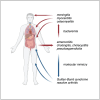Campylobacter jejuni/ coli Infection: Is It Still a Concern?
- PMID: 39770871
- PMCID: PMC11728820
- DOI: 10.3390/microorganisms12122669
Campylobacter jejuni/ coli Infection: Is It Still a Concern?
Abstract
Campylobacteriosis is a leading cause of infectious diarrhea and foodborne illness worldwide. Campylobacter infection is primarily transmitted through the consumption of contaminated food, especially uncooked meat, or untreated water; contact with infected animals or contaminated environments; poultry is the primary reservoir and source of human transmission. The clinical spectrum of Campylobacter jejuni/coli infection can be classified into two distinct categories: gastrointestinal and extraintestinal manifestations. Late complications are reactive arthritis, Guillain-Barré syndrome, and Miller Fisher syndrome. In the pediatric population, the 0-4 age group has the highest incidence of campylobacteriosis. Regarding the use of specific antimicrobial therapy, international guidelines agree in recommending it for severe intestinal infections. Host factors, including malnutrition, immunodeficiency, and malignancy, can also influence the decision to treat. The Centers for Disease Control and Prevention (CDC) has identified antibiotic resistance in Campylobacter as a 'significant public health threat' due to increasing resistance to FQs or macrolides. Although numerous vaccines have been proposed in recent years to reduce the intestinal colonization of poultry, none have shown sufficient efficacy to provide a definitive solution.
Keywords: Campylobacter; antibiotic resistance; foodborne illness; pediatric population.
Conflict of interest statement
The authors declare no conflict of interest.
Figures



References
Publication types
LinkOut - more resources
Full Text Sources

